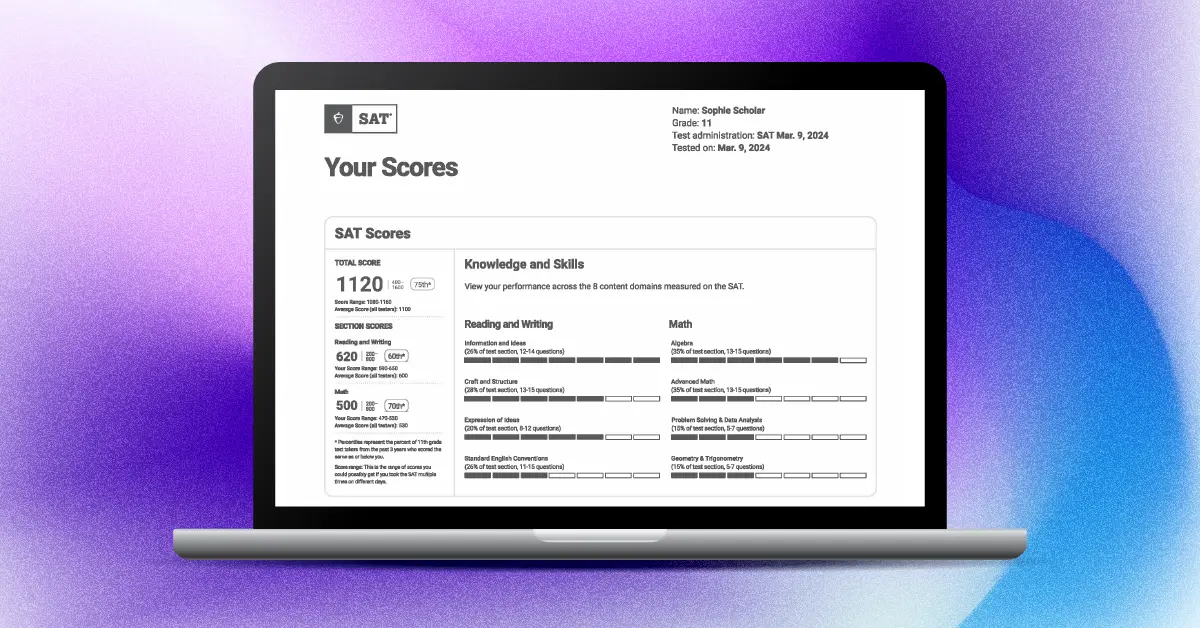Here is some background information to help you strategize with time management. Use this breakdown to understand the scoring process, set goals, and understand your scoring baseline. This will ultimately help navigate why you are running out of time.
Understand the Scoring Process
When it comes to saving time on the Math section of the SAT® exam, understanding the scoring process is a great place to start. You should know that your results are based on your number of correct answers, and each question is worth the same amount of points. If the hard questions and easy questions are worth the same amount of points, and you need a raw score of 35 to reach your goal score of 570, then there is potential for you to guess on about 23 more difficult questions. Running out of time can be resolved by understanding your goals and using the scoring process to strategize.
Set Goals and Strategize
Setting a goal score can help you prioritize the number of questions you must complete and answer correctly. Not every student is looking for a perfect score. You can base your goals on the scores that resulted in acceptances for students attending the colleges you are applying to. This step may save you some stress in finding that you don’t need to score perfectly for this section of the SAT exam to meet the expectations of your potential colleges or universities. Every school is different, so be sure to do some research and decide on a goal score. Note that the final SAT score is based on a raw score. The raw score is the number of questions you answer correctly. This number is scaled to 200 to 800 points for your total Math score. Convert your total score into a raw score to determine how many questions you need to answer correctly. Since each question is worth the same amount of points, this step can help you prioritize the more straightforward questions that may not take as long. You may even be able to guess on a big chunk of the questions and still reach your target score. If you are running out of time on the Math section of the SAT exam, setting goals may introduce a strategy that only targets the questions that are necessary for your raw score.
Practice and Find Your Baseline
Setting goals starts with taking practice exams. You can gauge how much improvement is necessary (and realistic) by finding out your baseline. If you find that you are running out of time in your practice exam, mark the questions that slow you down. Remember that every problem is worth the same amount of points. Practice exams are a great place to find out which questions are worth skipping to save time. If you are not going for a perfect raw score, use your baseline to determine how much improvement is necessary.
Some Tips To Save Time
1. Find Your Weak Points and Recognize Areas That Waste Time
You can save some time by recognizing the questions that slow you down. In your practice exams, note the problems that require more steps and take longer to solve. If you can identify these questions as you work, you will save time answering them last. Once you finish the quicker questions, you can go back to the ones that take a lot of time. This strategy will allow you to work through more problems. Since each question is worth the same amount of points, it is crucial to recognize the questions that waste your time.
2. Be Aware of Outside Pressures
Your environment may be the source of interruptions on test day. If you find yourself running out of time on the exam, paying attention to the progress of students around you will slow you down even more. Be aware of outside pressures and distractions that come with comparison, and do your best to stay focused on your own process. These kinds of distractions are hard to prepare for, but you can practice and gain confidence with your personal strategies: when test day comes, be confident that your pacing is the correct pacing for your goals and skills.
3. Process of Elimination
You can save a lot of time by practicing your ability to eliminate answers. Even if you can’t immediately find the correct answer, this step can save time by minimizing the number of options to sift through. Choosing between two or three answers is a faster process than choosing between four.
4. Prioritize Questions
Now that you know that each question is worth the same amount, you can decide how many correct answers are necessary to achieve your goal score. The Math section of the SAT exam is organized to start with easy questions and progress into more and more difficult ones. Answer the questions that you can answer quickly first. Saving time on the exam may depend on your ability to move on from tedious or time-consuming problems. Prioritizing questions is a crucial step for maximizing the number of questions you can get to.
You can practice these tips for time management in the Math section of the SAT exam using UWorld’s SAT Prep Course. Recognizing the questions that waste your time and the distractions that affect your pacing are great tips to start. From there, you can practice efficiently eliminating answer choices and prioritizing questions based on how much time they require for solving. The prep course offers performance tracking tools that will help create a specific study plan. Use this tool to pinpoint your weak points and help recognize questions that take too long.




